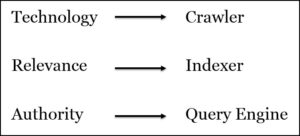Well, if you look around you will find a plethora of knowledge about what is SEO, what is its type, what is the need for SEO but the game becomes more interesting when you understand how does the search engine work.
It is so because once you are able to know how the search engine works, you will be able to design various tasks accordingly and take the favour of it.
While search engines are vastly complex pieces of software, at their core they’re made up of three distinct processes. Each process handles a different aspect of web search, and together they combine to provide relevant search results.
On a bigger picture,
The search engine runs by 3 main processes:
- Crawler
- Indexer
- Query Engine
Crawler
This process is the web spider that crawls the web, follows links, and retrieves content. The crawler process of a search engine discovers new and changed content, as well as all the hyperlinks it can find. A crawler starts with the list of previously discovered URLs, as well as URLs supplied via XML sitemaps.
Indexer
This process takes the content from the spider and analyses it. It also looks at the links retrieved by the spider and analyses the resulting link graph. It basically tries to make sense of it all. The indexing process analyses the webpages retrieved by the crawler and assigns relevance values for the various different keywords it finds in the content, which are used for ranking purposes.
Query Engine
This is the front-end of the search engine, where search queries are processed, search intent and context interpreted and results shown according to various ranking factors. When a user performs a search, the query engine attempts to understand the intent and context of the search and supply the best results. It’ll retrieve the most relevant documents from the index and apply the various ranking factors to present a list of webpages to the user.

0 Comments